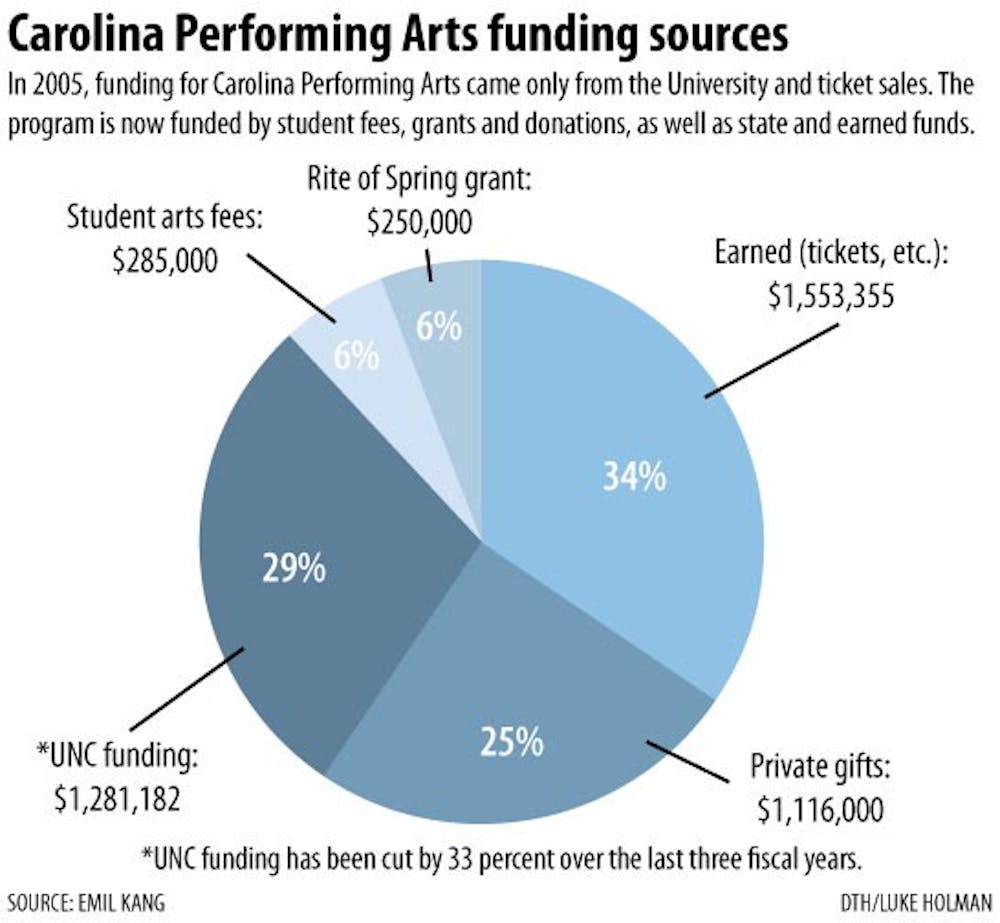Kang said that even though the past few years have suffered hard hits, a decline in funding was expected.
“We had the forethought to find other funding,” he said.
When the program began, Kang said that an endowment campaign was set up. It raised about $12 million, 5 percent of which would go to Carolina Performing Arts.
But the 2008 recession hit while givers were still paying off their donations and pulled the endowment under. Carolina Performing Arts received nothing, Kang said.
Donations and private gifts account for 25 percent — or $1.1 million — of this year’s $4.5 million budget.
“We’re not yet in the position of asking for more,” Kang said.
Most of the money Carolina Performing Arts brings in goes directly to paying the artists, Kang said.
“Our programming is reinvented every year,” he said. “We don’t have a permanent collection or an acting company.”
With two new hires leading the marketing staff, the outreach campaign has also been reinvented after cuts.
Marketing manager Ellen James said that they are using social media to give more in-depth — and free — exposure to the incoming artists.
“We’re using all the space of the Internet and exposing new or different content,” she said.
This season, Carolina Performing Arts is commissioning one work — Friday’s dance performance by Philadanco.
To get the day's news and headlines in your inbox each morning, sign up for our email newsletters.
Commissioned pieces are those chosen to be funded and produced by a program like Carolina Performing Arts.
In the past, the program has produced more than 10 first-time works in a season. That number has dropped progressively since the drastic cuts began.
Kang said the commissioned performances are a hallmark of the program’s work.
But by deferring premiere productions, it can showcase more works — even if they’ve been seen before.
“You can only cut so much before you’ll cease to be who you are,” Kang said.
Carolina Performing Arts is always among the most highly regarded arts programs in the sphere of public universities, Kang said.
He said he is not yet concerned, but budget cuts could eventually affect that prestige.
“Are we going to lose any ground?” he said. “If we keep it this way over time, yes.”
The program has since shifted its focus toward becoming the exclusive presenter of renowned or challenging works.
Chapel Hill was the only U.S. stop on the Deutsche Kammerphilharmonie Bremen’s world tour, and April’s production of “Snow White” by the Ballet Preljocaj is one of two East Coast stops for the company.
In the 2009-2010 season, Carolina Performing Arts introduced the Loading Dock series to avoid creation stagnation.
These shows are performed before marginally smaller audiences — 300 bleacher seats enclose the stage — and allow for artistically new and economically feasible projects, Kang said.
Mark Nelson, director of marketing for the executive office for the arts, said the Loading Dock series helps cut costs while keeping programming fresh.
“We want to give as much exposure for the littlest amount of money,” he said.
But both Kang and Nelson said seeing students fill the seats of Memorial Hall for world-famous performers makes the fight worth it.
About one-third of audience members at all shows are students, Kang said. For some performances — like December staple “The Nutcracker” — the student attendance is much higher. Kang said that about 1,100 of 1,434 seats for “The Nutcracker” are sold to students, making for a much lower revenue.
“We love it and we hate it,” he said.
Kang said he will continue to work to keep ticket prices low, hoping that students will continue to come out.
“You just don’t know whose life you’re going to change in that night,” he said.
Contact the Arts Editor
at arts@dailytarheel.com.



